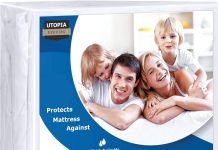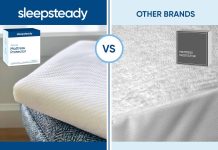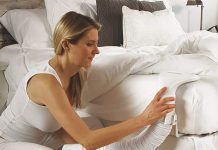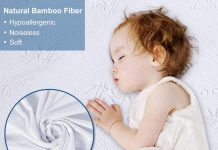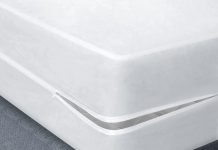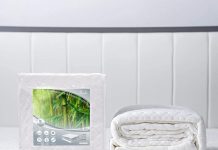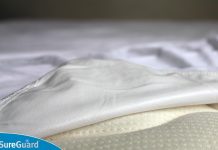Looking for a simple solution to keep those pesky bed bugs at bay? Look no further! We’ve got the lowdown on whether a mattress protector can effectively prevent bed bugs from invading your peaceful slumber. Bed bugs are the last thing you want to encounter while trying to relax, so read on to discover the answer and put those bed bug worries to rest.
Review contents
The Importance of Mattress Protectors
Protecting Your Mattress from Stains and Spills
As we spend many hours every night sleeping on our mattresses, it’s important to keep them protected from stains and spills. Accidents happen, whether it’s a spilled drink or a child’s bedwetting incident. Without a mattress protector, these stains can seep into the mattress, leading to unpleasant odors and potential damage. By using a mattress protector, you can create a barrier between your mattress and any potential spills, ensuring that your mattress stays clean and fresh for years to come.
Maintaining Mattress Hygiene
Mattress hygiene is often overlooked, but it plays a crucial role in our health and well-being. Our mattresses accumulate sweat, dead skin cells, and body oils over time, creating an ideal environment for bacteria and allergens to thrive. Using a mattress protector can help maintain mattress hygiene by providing a barrier that prevents these substances from seeping into the mattress. A clean and hygienic mattress promotes better sleep and reduces the risk of allergies and other health issues.
Reducing Allergens and Dust Mites
If you or your loved ones suffer from allergies or asthma, mattress protectors can be a game changer. Dust mites are tiny creatures that feed on dead skin cells and thrive in mattresses. These microscopic creatures and their droppings can trigger allergies and respiratory issues. By using a mattress protector, you can create a barrier that prevents dust mites from infiltrating your mattress and coming into contact with your skin. This can significantly reduce the presence of allergens in your sleeping environment and provide relief for those with allergies or asthma.
Understanding Bed Bugs
What Are Bed Bugs?
Bed bugs are small, wingless insects that feed on the blood of humans and animals. They are reddish-brown in color and can be found in bedding, furniture, and other areas where people sleep or rest. Bed bug infestations have become a common problem in many households, causing discomfort and distress to those affected.
Common Bed Bug Habits
Bed bugs are expert hitchhikers and can easily be transported from one place to another through luggage, clothing, or used furniture. Once they enter your home, they seek out hiding spots near their food source, which is typically humans. Bed bugs are nocturnal creatures and are most active during the night when their victims are asleep. They are attracted to body heat and the carbon dioxide we exhale, which guides them to their unsuspecting hosts.
The Risks of Bed Bug Infestations
Apart from the inconvenience and discomfort of being bitten by bed bugs, there are other risks associated with infestations. Bed bug bites can cause itching, skin irritation, and in some cases, allergic reactions. In addition, the emotional and psychological impact of dealing with a bed bug infestation can be significant. The fear and anxiety of being bitten again can lead to sleep disturbances and mental stress. Therefore, it is crucial to take preventative measures to avoid bed bug infestations in the first place.
Can Mattress Protectors Prevent Bed Bugs?
How Bed Bugs Infest Mattresses
Bed bugs are notorious for their ability to hide in small cracks and crevices, making it easy for them to infest mattresses. They can crawl into the seams and folds of mattresses, where they find a safe haven and regular access to their food source. If you suspect a bed bug infestation, it is essential to thoroughly inspect and treat your mattress along with other potential hiding spots in your home.
Types of Mattress Protectors
While mattress protectors primarily serve to protect against stains and spills, some models are specifically designed to prevent bed bugs. These specialized mattress protectors are made with a tightly woven fabric that prevents bed bugs from passing through. They often feature a zippered encasement that fully covers the mattress, leaving no gaps for bed bugs to enter or escape.
Effectiveness of Mattress Protectors against Bed Bugs
Although mattress protectors with bed bug protection can provide an extra layer of defense, they are not foolproof. While they can prevent the infestation of bed bugs that are already present in your mattress, they cannot prevent bed bugs from infesting other areas of your home or being introduced into your sleeping environment from external sources. Therefore, while mattress protectors are a valuable tool in the fight against bed bugs, they should be used in conjunction with other preventive measures.
Factors to Consider When Choosing a Mattress Protector
Material
When choosing a mattress protector, the material is an important factor to consider. Look for protectors that are made from high-quality, breathable materials that are comfortable to sleep on. Waterproof or water-resistant materials are ideal for protecting against spills and stains. It’s also worth considering hypoallergenic materials if you have allergies or sensitivities.
Encasement Type
There are two main types of mattress protectors: fitted sheet-style and zippered encasement. Fitted sheet-style protectors are similar to a regular fitted sheet and are easy to remove and clean. Zippered encasement protectors fully encase the mattress and provide enhanced protection against bed bugs and allergens. Consider the level of protection you need and choose the encasement type accordingly.
Secure Closure Mechanisms
If you opt for a zippered encasement mattress protector, ensure that it has a secure closure mechanism. Look for protectors with small teeth or tight zippers that can prevent bed bugs from escaping or entering. A velcro flap or an additional locking mechanism can provide an extra layer of security.
Alternative Methods to Prevent and Control Bed Bugs
Regular Mattress Inspections
To detect bed bugs early and prevent an infestation, it’s important to regularly inspect your mattress and bedding. Look for signs of bed bugs, such as dark spots (bed bug feces), bloodstains, or the bugs themselves. Pay close attention to the seams, folds, and crevices of your mattress. If you suspect a bed bug infestation, take immediate action to address the problem.
Proper Bed Bug Treatment
If you find evidence of bed bugs, proper treatment is essential to eliminate the infestation. Bed bugs can be challenging to eradicate, so it is often recommended to seek professional help. Pest control experts can provide effective treatment options such as heat treatments or insecticide treatments to eliminate bed bugs from your home.
Using Bed Bug Proof Encasements
In addition to mattress protectors, using bed bug proof encasements is another preventive measure to consider. Bed bug proof encasements fully cover the mattress, box spring, and pillows, creating an impenetrable barrier against bed bugs. These encasements are made with specially designed fabrics that are resistant to bed bug penetration, offering an additional layer of protection for your sleeping environment.
Additional Tips for Preventing Bed Bugs
Regular Cleaning and Vacuuming of Mattresses
Regularly cleaning and vacuuming your mattress can help reduce the risk of bed bug infestations. Vacuuming can remove any bed bugs or eggs that may be present, as well as any dead skin cells or other debris that can attract these pests. Additionally, washing your bedding at high temperatures can help kill any hidden bed bugs.
Avoiding Secondhand Furniture
When it comes to bringing new furniture into your home, particularly beds or mattresses, it’s best to avoid secondhand items. Bed bugs can easily hide in cracks and crevices of furniture, and purchasing used items increases the risk of introducing bed bugs into your home unknowingly. If you do choose to buy secondhand furniture, thoroughly inspect it for any signs of bed bugs before bringing it into your home.
Proper Disposal of Infested Items
If you discover bed bugs infesting your mattress or other furniture, it is crucial to dispose of them properly. Simply discarding infested items without taking proper precautions can lead to the spread of bed bugs to other areas of your home or to neighboring homes. Consult local pest control authorities or waste management services for the proper methods of disposing of bed bug-infested items to prevent further infestations.
Conclusion
In conclusion, mattress protectors are essential for maintaining the cleanliness, hygiene, and longevity of your mattress. While they may not fully prevent bed bug infestations on their own, they can provide an additional layer of protection. By regularly inspecting and treating your mattress, using bed bug proof encasements, and implementing other preventive measures, you can effectively reduce the risk of bed bugs and enjoy a clean and comfortable sleeping environment. Remember to choose a high-quality mattress protector that suits your needs, considering factors such as material, encasement type, and secure closure mechanisms. With proper care and attention, you can keep your mattress protected from stains, spills, allergens, and, to some extent, bed bugs.



